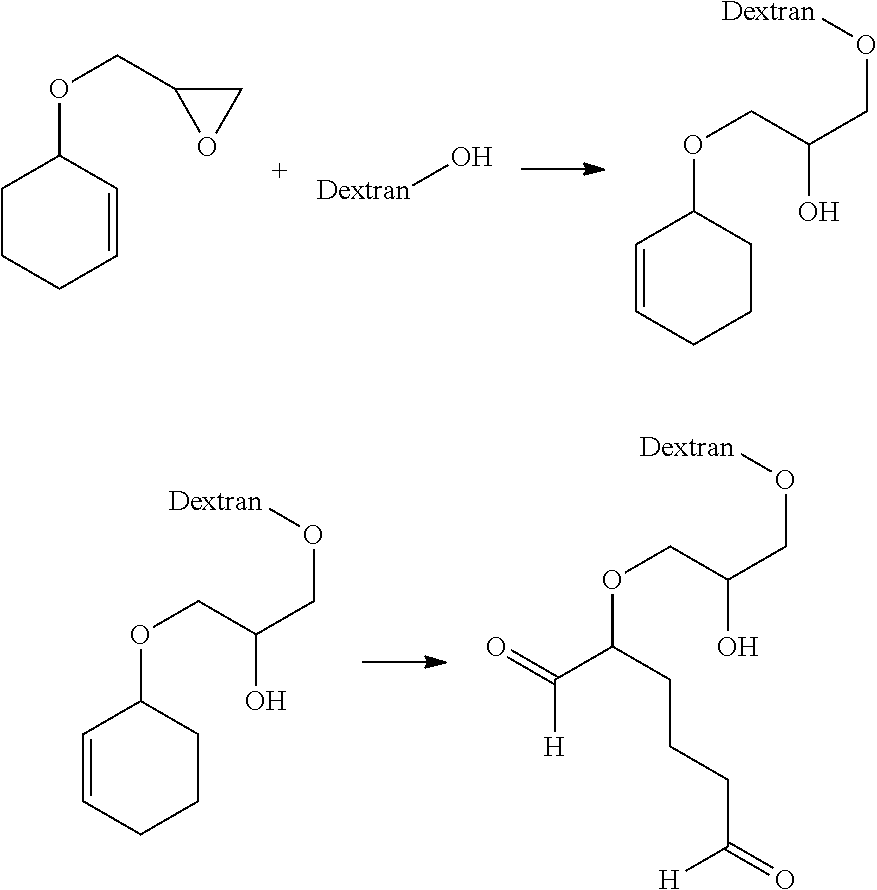Aldehyde-functionalized polysaccharides
a technology of aldehyde and polysaccharide, which is applied in the field of medical adhesives and sealants, can solve the problems of limited internal application use of fibrin-based adhesives, slow curing of fibrin-based adhesives, and general inapplicability of conventional tissue adhesives to a wide range of adhesive applications
- Summary
- Abstract
- Description
- Claims
- Application Information
AI Technical Summary
Benefits of technology
Problems solved by technology
Method used
Image
Examples
example 1
Preparation of Dextran Having Pendant Dialdehyde Groups (DAFD-10-16)
[0060]Dialdehyde-functionalized dextran in which the pendant dialdehyde groups are linked to the dextran backbone by an ether bond was prepared using a three step procedure.
Step 1:
[0061]To a 300 mL, two-neck flask equipped with a magnetic stir bar and nitrogen inlet was added 74.3 mL of a 40 wt % sodium hydroxide solution and 0.94 g (2.91 mmol) of tetrabutylammonium bromide. The solution was cooled to 5-10° C. and treated with 5.0 g (59.44 mmol) of 3-cyclopentene-1-ol followed by dropwise addition of epichlorohydrin 22.0 g (237.76 mmol) over a 20 min period. The reaction mixture was stirred at room temperature overnight. Then, the reaction mixture was poured onto approximately 50 mL of ice / water and stirred to give a solution, which was extracted three times with 50 mL portions of diethyl ether. The combined organic layers were washed with brine solution until neutral to litmus and dried over MgSO4. The solvent was ...
example 2
Preparation of Dextran Having Pendant Dialdehyde Groups (DAFD-Ester Linked)
[0069]Dialdehyde-functionalized dextran in which the pendant dialdehyde groups are linked to the dextran backbone by an ester bond was prepared using a two step procedure.
Step 1:
[0070]Into a 50 mL, 3-neck flask equipped with magnetic stir bar and a reflux condenser was placed 22 mL of dimethylacetamide (DMAC) followed by 1.817 g (11.217 mmol) of dextran having a weight-average molecular weight of about 9 to about 11 kDa and 1.09 g (25.71 mmol) of lithium chloride. A suspension formed, which was heated to 90° C. for one hour until a clear solution resulted. The solution was cooled to room temperature and 0.91 mL (11.217 mmol) of pyridine was added followed by dropwise addition of 2.18 g (11.217 mmol) of 3-cyclopentene carbonyl chloride. 4-Dimethylaminopyridine (DMAP, Aldrich) (30 mg) was added and the mixture was heated mixture at 60° C. overnight i.e., approximately 20 hours). After cooling, the resulting bro...
example 3
In Vitro Degradation of Hydrogels Formed Using Dialdehyde-Functionalized Dextrans
[0075]This Example demonstrate the higher stability of a hydrogel prepared using aldehyde-functionalized dextran having pendant dialdehyde groups where the linkage to the dextran backbone is an ether linkage, as described in Example 1, compared to a hydrogel prepared using aldehyde-functionalized dextran having pendant dialdehyde groups where the linkage to the dextran backbone is an ester linkage, as described in Example 2.
Preparation and Stability of Hydrogels
[0076]An aqueous solution containing dialdehyde-functionalized dextran DAFD-10-16, prepared as described in Example 1, or DAFD-10-Ester Linked, prepared as described in Example 2, at a concentration of 20 wt % was mixed with an aqueous solution containing multi-arm PEG amine P8-10-1 (25 wt %) using a double barrel syringe (Mixpac Systems AG (Rotkreuz, Switzerland) fitted with a 16 or a 12 step static mixer (Mixpac Systems AG) to form a hydrogel. ...
PUM
| Property | Measurement | Unit |
|---|---|---|
| weight-average molecular weight | aaaaa | aaaaa |
| weight-average molecular weight | aaaaa | aaaaa |
| weight-average molecular weight | aaaaa | aaaaa |
Abstract
Description
Claims
Application Information
 Login to View More
Login to View More - R&D
- Intellectual Property
- Life Sciences
- Materials
- Tech Scout
- Unparalleled Data Quality
- Higher Quality Content
- 60% Fewer Hallucinations
Browse by: Latest US Patents, China's latest patents, Technical Efficacy Thesaurus, Application Domain, Technology Topic, Popular Technical Reports.
© 2025 PatSnap. All rights reserved.Legal|Privacy policy|Modern Slavery Act Transparency Statement|Sitemap|About US| Contact US: help@patsnap.com



